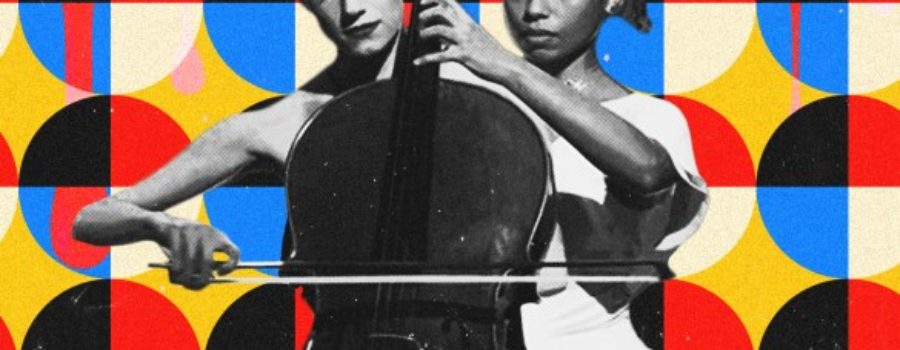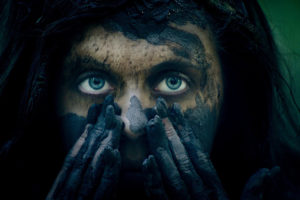[Published at Living Life Fearless] Netflix’s The Perfection is an intelligent entry into the body-horror subgenre. The sleeper-hit turned heads with its unique, #MeToo-infused take on the classic battle-of-the-sexes trope, continually subverting audience expectations during the entirety of its efficient runtime. For readers who haven’t seen The Perfection, proceed with caution; the film also caused a portion of viewers to vomit at the extreme nature of a certain self-mutilation scene.
Immediately upon viewing The Perfection, the audience is confronted with Vanja Cernjul’s clever cinematography and Richard Shepard’s thoughtful direction, both of which subconsciously create a shifting power dynamic through the use of color associated with the two main characters, Charlotte (Allison Williams) and Lizzie (Logan Browning), and the antagonist, Anton (Steven Weber), throughout the film.
Charlotte and Lizzie’s Primary Colors & Motives
Initially, Charlotte is constantly surrounded by various shades of Yellow, and Lizzie by hues of Blue ― through the use of setting, costume, and particularly lighting. Over the course of the film, however, their color coding slyly strategically switches. I know, I know, color in film is one of the most basic forms of expression and symbolism. However, effective placement of color paired with person in The Perfection, a powerfully polychromatic picture, is particularly pointed.
When she arrives in Shanghai, Charlotte’s bag is Blue, at once a guise to hide her whirlwind of emotions from confronting her abuser for the first time in ten years since the abuse last occurred, as well as the little remaining grasp she has of the memories of her experience as Anton’s most prized student.

As soon as Charlotte confidently walks through the neon Yellow-lit hallway to Anton’s party honoring Lizzie, she also wears a Blue dress and eyeshadow, both of which appear Green under the overpowering Yellow lighting, foreshadowing her metamorphosis throughout the film. However, it isn’t the Blue on Charlotte that stands out, it is that which pops on Lizzie, with her nearly fluorescent Blue dress and dark Blue choker, emboldening her piercing Blue eyes, which are further accentuated by Cernjul’s cinematography. The Blue attire they both wear is emblematic that the two initial rivals are more similar than dissimilar, and the haunting pasts they’re actively covering up.
Lizzie has a shade of Red on her dress at the party in a design that seemingly bleeds onto her, reminiscent of a Jackson Pollock painting, evoking an almost violent image, alluding to her tortured past. One that she hasn’t processed yet. One that Charlotte helps her radically come to terms with.
Red, Anton, & A Tale Of Two Survivors
Red is surrounded by Anton and his wife, Paloma (Alaina Huffman), complicit in her husband’s crimes, throughout The Perfection. At the party, Anton wears a Red scarf, his students use Red cellos, the attendees sit in Red theater chairs, Paloma wears a Red dress, the wooden walls of their secret-laden home in Boston are stained in a dark, rich iteration of the color, Anton dons a Red night gown behind said walls, and the Red stage in Anton’s secretive chapel is outlined with Yellow, the remnants of Charlotte’s former “reign” as first chair as well as scarring memories of his abuse; a twisted, visual token from their shared pasts. When Charlotte and Lizzie perform for Anton on stage for the first time together over a tasteful sex scene, distinct Red banners lurk ominously over them in the background, as if his hollow eyes stalk omnipresently over every facet of his prey’s personal lives ― a very real fear for victims of sexual assault.

Charlotte is the seeming protagonist coming to “support” her replacement cellist, Lizzie. Lizzie is the seeming dual protagonist. As their figurative true colors show, they fight each other, their power dynamics twisted over the course of the narrative, the Yellow and Blue vacillating between Charlotte to Lizzie before Charlotte’s revenge plot is eventually revealed.
The ephemeral setting of Charlotte’s childhood flashbacks are soaked with Green ― she has already processed her pain ― she can see the figurative Green at the end of the tunnel. She feels she must take revenge on Anton to finally move forward. A feeling, an occasion, a symbolic closing of a dark chapter in her life that she wants to enact with someone who has endured the same abuse that she had at the hands of the same man.
Charlotte first views Lizzie on a Red billboard, conveying the idea that she is still under Anton‘s proverbial spell towards the beginning of The Perfection. When they perform together, Lizzie uses a Red bow and Charlotte uses a Yellow bow, ensuring her physical and emotional freedom from Anton’s dangerous grasp. Charlotte has already broken free of Anton’s psychological vice grip by experiencing a personal hell ― ten years of caring for her dying mother while her own wellbeing disintegrated into clinical depression as she digested her tainted childhood. Lizzie has yet to see the larger picture that Charlotte does. Alas, Charlotte feels she must use extreme measures to allow Lizzie to realize the horrifying truth about Anton, which she learned long ago: Anton is a manipulative, abusive monster without any regard for the wellbeing of his students.
The Perfection is a Vantablack tragicomedy, and the utilization of color accentuates its themes of sexism, mental illness, the impossible societal expectations of women…
The audience learns that Anton’s horrific actions, coupled with the death of Charlotte’s mother and her diminishing ability to perform at Anton’s desired level, led to Charlotte’s breakdown which, in turn, motivated her to concoct her master plan to exact revenge on him with a partner, while also saving said partner from a similar fate of dangerous self-degradation. At first, it seems like Charlotte’s actions are a result of jealousy. However, in Charlotte’s own, twisted way, she fully intends to free Lizzie from Anton for Lizzie’s own wellbeing.
Yellow universally represents positive qualities such as happiness, intelligence, and emotional strength, but also less-flattering traits like jealousy (Charlotte’s seeming desire to regain first chair), impulsivity (Charlotte’s shocking acts of violence), and dark Yellow with egoism and depression (Charlotte’s major depressive breakdown).
While Blue (fittingly, widely regarded as the most favored color) universally represents versatility, intelligence, creativity, and relaxation, it is also associated with a lack of emotion (Lizzie is perceived as the emotional polar opposite of Charlotte by their teacher, and Charlotte aims to change that perception) and loss of appetite (Lizzie is poisoned later in the film by a seemingly vindictive Charlotte). An early picture of Charlotte as a child with a cello displays her in a Blue dress. The flashback when she first sees Lizzie as a child also captures her in Blue attire. Lizzie used to idolize Charlotte because Charlotte used to be her. Blue reflects increasingly off of Charlotte’s face as the film progresses, she gains more control, and seemingly begins to take Lizzie’s place before her plan becomes more concrete and the two join forces.

Lastly, Red is associated with our most primal, physical needs such as sex (oftentimes the id) in Anton’s case, a twisted urge to satisfy a perverted desire. The dark red displayed in The Perfection harnesses a particularly masculine energy. Although Red is aligned with love, passion, and friendship, it also represents anger, malice, aggression, war, destruction, manipulation, and control ― Anton’s essence.
Beyond every coy, colored smoke and mirror throughout The Perfection, the true antagonist remains Anton. The film’s title refers to his obsession for achieving an unattainable goal. He punishes his young female students who fail to fulfill his expectations by sexually assaulting them. His lifelong, abusive mentor-mentee relationship with these students created a Stockholm Syndrome-esque dynamic with, first, Charlotte, and, then, Lizzie, wherein they grew equally obsessed with and attached to him, their honed skill behind the cello, and the shared idea of perfection.
When Yellow & Green Join Forces
While Charlotte and Lizzie dance in the club, the Yellow shades leave Charlotte’s essence and migrate to the background of each frame, while an incandescent Blue lighting moves to the foreground, reflecting off of the two enamored students from an unseen empyrean as they share an impassioned kiss. Charlotte temporarily steps out of her comfort zone and fully into Lizzie’s, slowly gaining her trust as she earns her romantic affection.
And so begins Charlotte’s reconditioning of Lizzie, undoing Anton’s psychological damage, and the clever color oscillation commences.
While traveling in a Yellow tour bus to the countryside on their detour, in Charlotte’s world again as her plan commences, Lizzie begins to hallucinate after Charlotte poisons her. Lizzie’s Des jacket and Yellow, Blue, and Red plaid dress symbolize her conflicting identity, influenced by both Anton and her childhood idol, Charlotte. As she falls increasingly ill, she sheds the jacket, figuratively relinquishing Anton’s control over her life by handing it to Charlotte, unwittingly putting her fate in her hands, only to be handed a hatchet in return.
During Lizzie’s descent into madness, Charlotte slowly, painstakingly deconstructs every facet of her reality as she knows it. Lizzie becomes the victim twice over, as Charlotte did, eventually joining her in solidarity as the revenge plot is contextualized. Before that, in order to subscribe to Charlotte’s plot, Lizzie must make her separation from Anton official.

When Lizzie attacks Charlotte in her home, the moonlight reflecting on Charlotte’s face is soaked in a deep sky Blue, highlighting the more muted Blue sweater she wears; she even puts on a tough front, a mask, the blue disguise in her own home, a place where most people feel comfortable to let their guards down, while glancing out of her windows in a state of controlled paranoia. Recovery from abuse is a lifelong process. The Blue, confidence in collaboration in this instance, is now seen as only part of both of their essences. When Blue and Yellow are conjoined, they form more complete human beings, as Charlotte and Lizzie augment each other as partners in multiple senses of the word.
Charlotte and Lizzie set aside their “minor” misunderstandings in order to take down their common antagonist, Anton, and the oscillating Yellow and Blue merge together. Charlotte and Lizzie become a team, forming a mostly proverbial shield of figurative Green. Together, they complete each other, literally, as a couple and musical duet ― with their good arms playing ― as well as figuratively, their personalities perfectly complementing each other as their colors collide. Green universally represents renewal, harmony, and growth, as these two women enter their new leases on life after defeating their former teacher.
During the climax, when the audience is still led to believe that Lizzie wants revenge on Charlotte and not Anton, there are no admixtures of Red infused with her essence; for the first time since returning to Boston, we see Yellow associated with Lizzie, the prominent Yellow lighting from the stage reflecting off of her face, finally alluding to her involvement in Charlotte’s plan in the eyes of the audience.
Conclusion
The Perfection is a Vantablack tragicomedy, and the utilization of color accentuates its themes of sexism, mental illness, the impossible societal expectations of women, navigating lasting, compounding childhood trauma, and the film’s complete reworking of the tired battle-of-the-sexes trope. This is a revenge tale. This is a love story. This is a nondiscriminatory horror film fit for the #MeToo era and beyond. This film is gorgeous. And not just for the sake of being gorgeous. This is a film out of which its audience can get more and more with repeat viewings. This is a film that sticks with you. A film that lingers, much like the vivid colors in each of its meticulously-staged frames.







![Netflix’s ‘Iron Fist’: The Supporting Cast Steals The Show In The Greatly Improved Season 2 [Review]](https://www.makingacinephile.com/wp-content/uploads/2018/11/Iron-Fist-Season-2-1200x520-300x200.jpg)
Leave a Reply
Your email is safe with us.